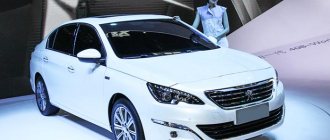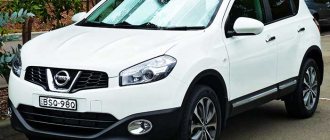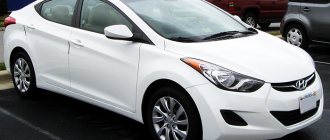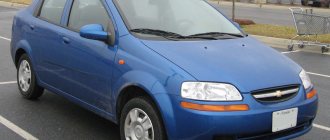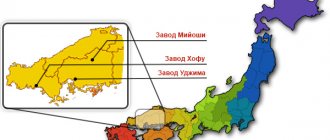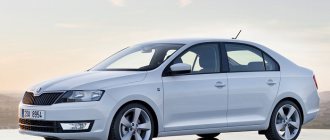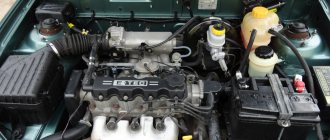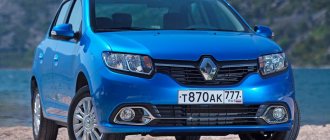The South Korean company Kia has always been famous for its high-quality and inexpensive cars. Recently, thanks to the emergence of new, more advanced models, Kia products are one of the most popular in the global automotive market.
Photo: Kia Rio 2017
Of course, the prominent representative of this “golden series” is the Kia Rio. Experienced car enthusiasts know that this model is considered one of the most practical and stylish cars, the development of which used the latest technologies.
However, despite the general assembly concept, the models assembled at different factories differ quite noticeably from each other. Therefore, for a more objective assessment of the Kia Rio, it is important to know at which plant it is produced.
In today's article we will talk about the most powerful factories of the Korean company Kia, where the Rio model is assembled.
Kia's main factories
Kia products are systematically conquering the European, Asian and American markets. The growing model range and rising sales force us to increase production. The main plant has acquired branches located in other countries.
The place where the Kia Rio is assembled affects the price, which depends on tax duties and logistics costs.
Seven main production points:
- The main enterprise is located in the South Korean city of Gwangmyeon.
- In the city of Yancheng in China, Kia Rio is produced for local consumers.
- Cars assembled in Ecuador are supplied to the South American continent.
- Assembly for southeast Asia is carried out in Indonesia.
- Relatively recently, a plant was opened in the Philippine capital, providing cars to the local market and the markets of neighboring countries.
- The plant, second only to the Korean one in size, was built in St. Petersburg. Cars are produced here for Russia, the CIS and Eastern European countries.
- The AVTOTOR plant in Kaliningrad does not assemble the Kia Rio sedan. This is one of the few Kia models that is not made here. The rest of the model range comes off the assembly line regularly and is sold on the Russian, Baltic and Central European markets.
Almost all Kia Rios offered in Russia are assembled here. But cars come to Central Europe and the USA directly from Korea.
Top disadvantages of Kia Rio X-Line
“New Rio X-Line from RUB 789,900,” says Kia’s official website. What kind of animal is this? Perhaps it’s worth taking, because it’s inexpensive and looks quite attractive. The new model, which recently appeared in the budget segment of Kia, really made a splash among a small segment of motorists, fitting into the upward trend set by AvtoVAZ in time. They were also supported by Renault, who showed his vision of the “Cross” version of his popular Logan .
So, the Korean automaker has prepared a new product based on the Rio model. Before us is an unusual mixture of an all-terrain hatchback with the spaciousness of a full-fledged crossover. The model is distinguished by its increased ground clearance and unusual appearance. The elevated hatchback comes with a variety of electronic driver assistance systems, including HAC (Hill Assist Control), Emergency Brake Assist System (ESS), Stability Control and ABS. In general, a good set of assistance systems is already included in the initial configuration.
By the way, in the initial version the model will be equipped with a 1.4-liter engine with a capacity of 100 hp. s., which comes with a six-speed manual transmission. If you don’t want to purchase a small-volume engine, you can take a closer look at the 1.6-liter version with a capacity of 123 hp. With. in higher trim levels.
You can read more about the new product here: The cost of the new budget all-terrain vehicle Kia Rio (X-Line) has been announced
1. There is practically no sound insulation, the rubber is humming. Unfortunately, in the budget segment, finding a car with good noise is an impossible task. The automaker usually saves on “little things” that are not noticeable to the naked eye. Well, the fact is that after the euphoria from the purchase completely wears off and your ears hear all the delights of the clicking of pebbles on the fender liners, there is no particular problem. Little nothings of life.
3. Also, the keen eyes of experts noticed the appearance of rye on the front bumper amplifier, and this was after a mileage of only 11 thousand kilometers. Not much, let's be honest. Nevertheless, in general, owners have no complaints about the body’s resistance to corrosion. We hope that the story with the Creta crossover will not repeat itself.
4. But the steering wheel peels off quite quickly. They clearly saved on the quality of the upholstery on the steering wheel. In principle, there is nothing to be surprised at - cars from the budget segment often suffer from the disease of not the highest quality upholstery. For example, similar problems were identified on the Chevrolet Cruze. The steering wheel became covered with nasty faded dots after 50-80 thousand kilometers. Time will tell how long the steering on the Kia pseudo-crossover will last.
By the way, if we take into account the historical facts that new products of the recent past had to face, problems may appear on the upholstery: seats (eco-leather can tear), on door trim (plastic may be easily scratched) and so on. Not a fact, but anything is possible. The manufacturer must also meet the budget, and in today’s realities it is small.
I went by appointment to the dealer, they found the problem right away, apparently I wasn’t the first to come up with something like this. It turned out that the connector on the dashboard was not plugged in.”
We are not inclined to assume that an unplugged plug can be of any widespread nature. But, you see, it’s a kind of “breakdown”.
6. A warm engine idles a little bit. The nuance was most likely inherited from the Hyundai Solaris, which had exactly the same engine. No intervention required. Doesn't cause any problems. There is no need to panic, it is not the phase shifters that are dying.
Among the subjective shortcomings, forum users note the following: stiff suspension, gasoline consumption is high (perhaps these owners switched to Korean cars for the first time), gaps in body elements, not enough power and the trunk is too small.
Against the backdrop of the above “disadvantages,” we will speak out in defense of Kia - these are not problems, but an overestimation of an obviously budget car. You shouldn’t expect stellar endurance and perfection in everything from a public sector employee. Moreover, many of you know that a modern car is not any kind of standard of quality, even if we are talking about Ferrari or Maybach.
Hyundai/Kia plant near St. Petersburg
The plant where Kia Rio is produced in Russia is located in the Leningrad region. This is “Hyundai Motor Manufacturing Rus”, owned by Hyundai.
Hyundai Solaris/Kia Rio
Production includes a full cycle:
- stamping of large body panels;
- welding;
- painting;
- assembly.
Hyundai Motor Manufacturing Rus is the second largest automobile plant in our country. Koreans invested more than a billion dollars in its construction and development . The number of jobs has exceeded two thousand. Employees work three shifts and produce about two hundred thousand cars a year.
The production uses high-tech equipment that meets modern requirements. 230 industrial robots are involved in automated production processes. Almost all enterprises supplying Russian automotive components are located nearby in the North-Western District. Research centers contribute to the improvement and development of models.
Kia assembly in Russia
Manufacturing Kia Rio in Russia allows you to avoid import duties and reduce costs for delivering finished cars to dealerships. Thanks to this, it is possible to keep prices at an acceptable level.
Foreign assembly of Kia Rio
The country where the Kia Rio is assembled is encrypted in the VIN code. By the alphanumeric designation you can determine the place where a given batch is produced. This information is not confidential, it can be clarified at the place of purchase of the car.
The country of origin of the Kia Rio is Korea. As production began to expand, assembly lines began to open in European countries. The first were Slovakia and the Czech Republic. The question of whose assembly will be answered by the consultants of the showroom where Kia Rio cars are offered for sale. Currently, the machines are produced in Iran, Pakistan, India, Indonesia, Vietnam, Thailand, Ukraine and Russia. The displacement of a production line from national borders is a natural process that becomes a consequence of an increase in production volumes and consumption, this is a kind of search for sales points.
Since 2005, the Lutsk plant in Ukraine has been producing Kia Rio. Initially it was part of the Bogdan plant. The manufacturer produces not only Kia Rio, but also Sorento, Cerato, Opirus. However, it was the Rio that became the most popular and best-selling car. The batches were used to satisfy not only domestic demand, but also for export.
Despite the fact that the Kia Rio is assembled in many parts of the world, Korea is the country from which cars continue to be shipped. This trend is due to the fact that the Kia Rio has become a popular transport, whose price is advantageously combined with functionality.
Production of Kia Rio 4 in Russia
In July 2021, serial assembly of the Kia Rio 4 began in Russia. Production was established at facilities in St. Petersburg. This is a logical step, because before this, it was there that the previous generation cars intended for sale in our country were produced.
Kia assembly in St. Petersburg
The fourth generation sedan differs from the third in all respects - different exterior and interior, updated engines and technical components. Naturally, we had to redraw production lines, adapt and hone technological processes. This is a large amount of work, because the localization level here is 47%. Kia Rio is not assembled from imported car kits, but uses a cycle that includes welding and body painting.
Kia Rio 3
The preparation period began back in 2021. During this time, new industrial robots were put into operation, equipment was updated, and robots that applied noise-insulating coating and were responsible for painting were reconfigured. All production workers were trained and recertified, and engineers and technical specialists were sent to courses in Korea.
The manufacturer adapted the car taking into account the road and climatic conditions of our country and the wishes of customers. Development tests were carried out jointly by Russian and Korean engineers. Before the new Kia Rio went on sale, it was driven to its heart's content on the roads of Karelia, the Murmansk region, the Krasnodar region and the Elbrus region. Testers drove 850,000 km, testing the model in winter and summer conditions.
It takes 16 hours to release one car.
After this, technical control carries out a full quality check within two hours.
About the release of Kia Rio 3rd generation
At the same enterprise “HMMR” from 2011 to 2021 they made the 3rd generation Kia Rio. This model has become popular among our compatriots. Over the years of production, 568 thousand Rios left the factory gates.
The enterprise’s capacity was enough to assemble cars not only for Russia, but also for Kazakhstan and Belarus.
Car assembly process in Russia
The assembly standard for the “Korean” in Kaliningrad and St. Petersburg is the same. Each car produced at a domestic enterprise goes through 4 workshops:
- stamping shop (body parts);
- welding shop (body assembly);
- painting shop (applying corrosion protection, priming, painting, varnishing and polishing);
- assembly shop (equipping with units).
For the production of the body, the main raw material is galvanized steel Hyundai-Hysco. After preparing parts for welding, they undergo thorough quality control to ensure compliance with the manufacturer’s requirements.
Blanks from the stamping shop travel on rails to the welding shop, where they are fastened together using robotic technology.
Painting is the most scrupulous and lengthy process. In addition to galvanizing, priming and painting, all parts undergo thorough cleaning and drying. This allows the water-based enamel to lay down in an even layer. The paint is dried in a special European dryer.
In the assembly shop, the already painted body is equipped with all the necessary components: engine, suspension and interior, down to the smallest detail.
We determine the location of assembly by VIN number
All cars have a VIN identification, and the Kia Rio is no exception. It allows you to understand where the car was assembled and more. You can determine where the Kia Rio is produced by the first characters.
- Z94 – St. Petersburg;
- X4X – Kaliningrad;
- K – Korea.
Korean assembly Kia
The VIN is located: under the windshield, under the passenger seat in the front and on the pillar on the left side in the direction of travel.
Vin - number
FAQ
How does cruise control work?
— cruise control is activated by changing the position of the lever on the steering wheel. The limiter will determine the minimum allowable speed and stick to it. Returning to manual control occurs by pressing the Mode button again;
Kia Rio X-Line VS compared to what?
Most often this car is compared with Renault Kaptur, Lada Xray, Lada Vesta SW Cross, Kia Ceed, Renault Sandero Stepway, Kia Soul
Is Rio X-Line a hatchback?
Many car enthusiasts are interested in the question. In its pure form, the Kia Rio X-Line cannot be called a hatchback. five-door hatchback, giving it some crossover features. Thus, this is a symbiosis of the best qualities of the two models.
What are the disadvantages of the Kia Rio X-Line?
Mostly, owners complain about poor sound insulation, interior roominess, a small glove compartment, inconvenient seat adjustment, glare from the glossy dashboard on the windshield, weak optics, cheap scratchy plastic, poor climate control performance, problems with connecting the Android car, creaking interior, quick wear of brake discs , windage at speeds > 130 km/h, vibrations in the body from the cooling radiator.
What offers are there for purchasing on credit?
For example, when buying a car on credit worth 900 thousand rubles for 5 years, you will need to pay 21,125 rubles monthly, the average interest rate is 14%, plus you need to remember various payments for applying for a loan and preparing other documents.
Dealers who offer to buy a car on credit: Autogermes
What about sound insulation in a car?
The lack of sound insulation of the car's underbody and wheel arches leaves an unpleasant impression of the trip.
Can it be chipped or flashed?
It’s possible, small companies do this, and the benefits of chiptuning are increased power and reduced fuel consumption.
Kia Rio X-Line tuning options
The car can be decorated with deflectors on the hood and windows, rear bumper covers, metal pipe sills, original radiator grilles, and so on.
Kia Rio X-Line examples of the cost of consumable parts and accessories
- Front brake pads from 2800 rubles
- Wipers from 800 rubles
- Carpets for the interior from 1600 rubles
- Armrest from 2000 rubles
- Window deflectors from 1000 rubles
- Windshield from 2500 rubles
- Towbar from 11,000 rubles.
- Filters: cabin from 500 rubles, oil from 150 rubles, fuel from 1100 rubles.
Where can I get a Kia Rio X-Line for a test drive?
In Moscow: Major Auto In St. Petersburg: Kia-Shuvalovo
Dealers
The Kia automobile corporation has a developed network of dealers in Moscow and St. Petersburg. Car dealerships await customers where they can sign up for a test drive of the Kia Rio X-Line (just don’t forget your driver’s license):
- Irbis-Service, located at: Studeny proezd 7B.
- AutoGermes, located at: st. Ryabinovaya 43.
- KIA Center Agalat, located at 9th Leninsky Lane, 11.
- Favorit Motors, located at: st. Koptevskaya 69A.
- AA Major, located at: st. Pskovskaya, 13.
- AA Major Auto MKAD 18 km. located at: Dzerzhinsky, st. Alekseevskaya, 2a.
- Kia car dealership, located at: St. Petersburg, st. Kushelevskaya road 20.
The main differences between the Russian assembly of Kia
The production of Kia Rio began in Russia in 2006. Since then, the car has acquired some distinctive features:
- radiator grille shape;
- they make sedan cars that are not available in other countries;
- body parts are stamped in Russia from blanks created at Chinese enterprises;
- A model with a diesel engine is not available;
- slight differences in interior design and materials used.
The price of the Russian assembly is 5 thousand dollars higher compared to the Chinese version.
The first three characters of the VIN code on Russian-made cars:
- Z94;
- x4x.
The code is located in several places:
- on the side pillar on the driver's side;
- under the front passenger seat;
- under the windshield.
There are practically no other significant differences. All stages of production are strictly controlled, technology is followed, and certified specialists work. Design data and equipment are supplied from the Korean head office. In terms of reliability and quality, the cars are not inferior to foreign ones.
